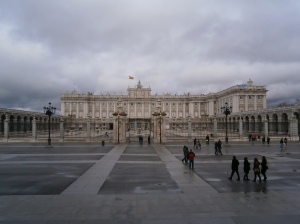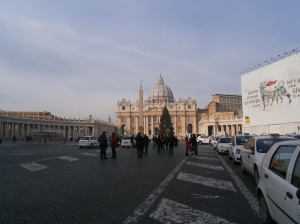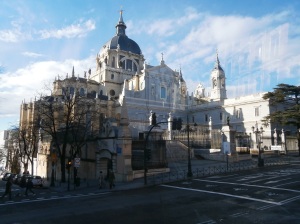Perhaps it is because we are American’s that we notice things others might not. We have been traveling through some countries hit pretty hard by the economic collapse. Many of these countries also have monarchies which they are still financially supporting. We have asked many residents in both Spain and the UK why they continue to pay for the monarchy even during these hard economic times. We never get a straight answer as to why, the reaction can be more akin to, ‘well it’s just something that is done’ and ‘how cheeky of us American’s to ask such a question’.
Watching the two hour, low key, swearing in ceremony, military parade and reception for the new King of Spain, Felipe VI, and seeing the Palace Real decked out in its regal splendor, I sat and wondered, what does it cost to keep this pomp and circumstance going? What does it cost for the guards, the cleaning staffs, the royal residences and the every day expenses to keep people in such opulence that literally are paid to wave their hands at the masses assembled on major events, cut ribbons at the opening of buildings, and who slam champagne bottles against the side of ships to christen them. I’m still thinking; nice gig if you can get it.

The stunning Palace Real in Madrid, Spain. King Felipe VI and his young family greeted tens of thousands of people here after he was sworn in as the new King of Spain (June 19, 2014). © Photo by Florence Ricchiazzi Lince
There are three types of monarchies; absolute (where the monarch has no or few legal restraints in state and political matters); constitutional (the monarch maintains a unique legal and ceremonial role, but exercises limited or no political power) and elective (there are three of these still in existence the most famous of which is the Papal appointment in Vatican City).

St. Peter’s Cathedral in Vatican City, Italy. Many people do not think of the Pope as a Monarch but he is an elected one. © Photo by Florence Ricchiazzi Lince
Most countries used a monarch until the 19th Century. In the 20th century after World War I and II many countries abolished them. There are still 44 monarchies in the world today. Only two of them are absolute (the Kings of Swaziland and Saudi Arabia). The majority are ceremonial monarchies including those in Spain and the UK. A monarch’s powers and influence depends mostly on tradition, precedent, popular opinion, and law. Popular opinion is now at the forefront of both of the monarchies in the UK and Spain due to the misconduct of the generations that have come after the King or Queen. This misconduct has caused many to question whether the role of the monarchy is worth the money being spent on them. The calls for the monarchy to be abolished here in Spain increased dramatically in the last few years with the abuse of power by King Juan Carlos and also the business cheating scandal of the Infanta Cristina’s husband. The UK has had its share of scandals over the years as well.
Juan Carlos I of Spain became King in 1975 after helping to free Spain and depose the fascist rule of Francisco Franco. King Juan Carlos made Spain a democracy with himself as constitutional monarch. He enjoyed many years of high favorability ratings with the people of Spain. The tarnish began to gather on the crown in 2012 when people discovered the king took a luxury elephant-hunting trip to Botswana as they struggled to find jobs in a recession. When the king’s elder daughter Cristina was named a suspect in her husband’s allegedly corrupt business practices the resentment grew to a crescendo and talk began that perhaps it was time to abolish the Monarchy totally. Demonstrations to end the Monarchy are gathering steam here in Spain as the economy worsens. The King then decided, conveniently for health reasons, that it was time to abdicate his throne and hand it down to the younger, good-looking, vibrant Felipe whose approval rating is around 76 percent. This is no coincidence.

The Cathedral of Madrid where King Felipe VI married Queen Latizia in 2004. © Photo by Florence Ricchiazzi Lince
Most monarchies are hereditary where the position is given in an established order of succession which means that the heir to the throne is known well in advance of becoming monarch to ensure a smooth succession. Most Monarchies however were male heir to male heir no matter their place in the birth order. In 1980, Sweden became the first European monarchy to declare equal primogeniture, meaning that the eldest child of the monarch, whether female or male, ascends to the throne. Many countries have since followed suit such as the UK and this would have begun with any child produced from the union of William and Kate.

Loch Leven Castle, the last home of Mary Queen of Scots, Scotland. Her history reminds me that people will do anything to stay in power, and why not, being King or Queen comes with very big purse strings. © Photo by Florence Ricchiazzi Lince
The British and Spanish Royal Families are financed mainly by public money. Both Governments meet the cost of the Sovereign’s official expenditure from public funds including the costs of the upkeep of the various royal residences, staffing, travel and state visits, public engagements, and official entertainment. In 2012 the Queen received £7.9 Million pounds ($12.64 Million) to perform her duties. The King of Spain received 7.8 million Euros ($10.14 Million) for fiscal year 2014. The costs to run the rest of the empire in the UK in 2009 were £41.5 million ($66.4 Million), which did not include the cost of security provided by the police and the Army. In the UK the Queen and her family feed off multiple revenue schemes. In addition to her salary she feeds off the profits of the Duchy of Lancaster for expenses not borne by the Sovereign Grant. In 2010 they received £13 Million pounds ($20.8 Million) in income. This has to beg the question; what expenses? So far the Queen doesn’t pay for the upkeep of the palaces, the staff to keep the palaces running or for the security to keep her safe. The money from the Duchy is in addition to her stipend as Queen.
The madness doesn’t stop here however because The Duchy of Cornwall is a property portfolio held in trust for the people of England but used to meet the expenses of the monarch’s eldest son, the Prince of Wales, who receives revenue from it to pay for his official activities and property. Also feeding off this fund are his wife (the incredibly disliked Camilla), his son Williams’ entire family and his second son Harry, who all have their official expenses paid from Duchy income. For the fiscal year 2011-12 the Duchy paid Charles £18.3 million ($29.28 Million). Seriously, is Charles worth 18.3 million pounds?

Queen Isabella of Spain and King Ferdinand (she gave him the title but the rule was hers by birth); they were the Monarch’s who began the Spanish Inquisition to purge Spain of non-Catholics. Sometimes Monarch’s with power did not spare the people from madness. © Photo by Florence Ricchiazzi Lince
Even the Duke of Edinburgh (the Queen’s husband) receives the princely sum of £359,000 per year from the Treasury ($574,400). What exactly does he need to draw a salary for since all of his other expenses are covered? Isn’t anyone adding up the real cost of the Monarchy to the people who are supporting it?
The Queen is reportedly worth $450 Million dollars based on personal real estate, jewelry and other assets. The King of Spain has not had his personal wealth disclosed. Neither sovereign is transparent in the filing of their income taxes so no one really knows how much either one is really worth. Would the CEO of any major corporation be allowed such secrecy?
If one takes away the need to fund the Monarch’s and just let them exist on their own wealth the countries could put that money to better use by building a better medical environment for the poor, fund food and other lifestyle programs for the needy, perhaps even decrease the tax structure of the country as a whole; it is staggering to think of the programs that could be funded. It is hard as an outsider to see the poverty in the streets in these countries and then to see the pomp and opulence of the palaces that exist and wonder why would anyone continue to fund the lifestyle of those that can afford to live on their own while those that cannot feed their families beg for food or coin in the streets. Or am I the only one who finds this absurd in this day and age?

Mike with the Queen of Knin, Croatia. All Monarchs’ should be as wonderful and warm. This Monarchy disappeared millennia ago, as perhaps all Monarchies should. © Photo by Florence Ricchiazzi Lince
Yes, the new Royal Family here in Spain is incredibly good looking, youthful and of good moral character. And William, Kate and little George are wonderful in the UK. If the people in these countries insist on keeping the hand waving monarchies going who am I to pooh pooh their loyalty. Back in the United States I will keep abreast of the activities of both Monarchies and secretly I’ll be hoping that Elizabeth II will find a way to abdicate, and give the crown to William, but there’s that cheeky American thing again.
Florence Lince